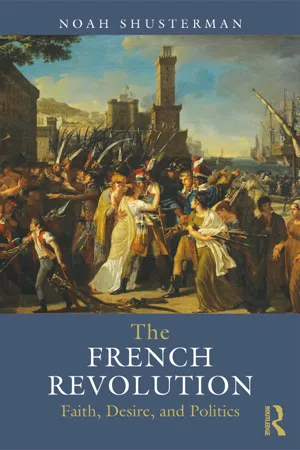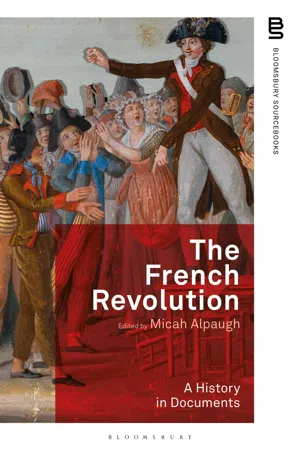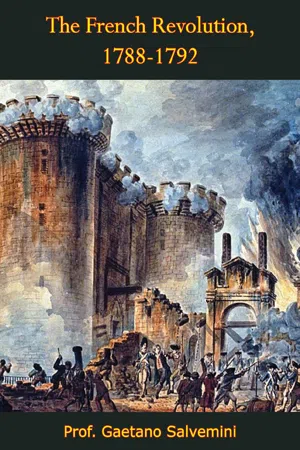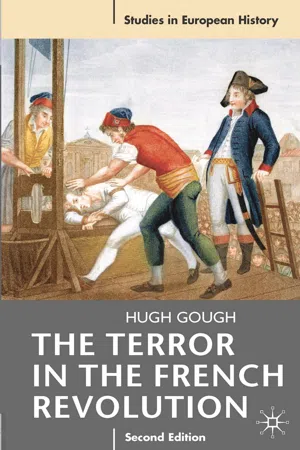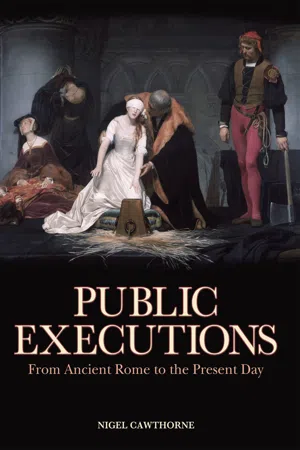History
September Massacres
Written by Perlego with AI-assistance
Related key terms
Related key terms
1 of 4
Related key terms
1 of 3
6 Key excerpts on "September Massacres"
- eBook - ePub
The French Revolution
Faith, Desire and Politics
- Noah Shusterman(Author)
- 2013(Publication Date)
- Routledge(Publisher)
The more horrific version of this story is the more common one, hard as it may be – even in this context – to believe. There is no surprise, though, that as horrible as the events were, the stories about those events could exceed the horror. The September Massacres were borne of a convergence of circumstances: the power vacuum, the relative anarchy in Paris, the deteriorating war situation. A big part of that mix, though, was the difficulty for anyone to separate truth from fiction, news from rumor – a situation true at any time of the Revolution, but more crucial, more tragic, at key turning points. Was the war going badly? Yes. Were the armies marching toward Paris? Yes. Was there a plot among the prisoners to bring ruin to the Revolution? No. The assassins were acting on news, some of which was accurate, some of which was not; if news of their own events mixed the accurate and the inaccurate, it is hard to be surprised.The rest of September 3, the massacres continued. That night Marat wrote an open letter to the rest of France, calling on the provinces to follow Paris’s lead. He wrote that some of the “ferocious conspirators” in prison in Paris had been “put to death by the people, acts of justice that seemed necessary.” It was now time thatthe entire nation … adopt this means so necessary to public salvation, and all of the French should cry out, like the Parisians: we are marching on the enemy, but we will not leave behind us these brigands, to cut the throats of our children and our wives.56By the next day things would become even worse. With few priests and few aristocrats left to kill, the crowd moved to other prisons. The number of assassins was not high; it was probably several hundred, not the sort of number of Parisians that had stormed the Bastille or the Tuileries. The mass indifference, or even the passive approval, had let this occur.The Legislative Assembly made several attempts to talk to the people participating in the massacres, sending out deputies to address them, but to no avail. Rather than sending soldiers, the Assembly was reduced to sending an old man – Dusaulx – who stood on a chair trying, in vain, to get people to listen to him. The Commune had voted salaries for the assassins, although they had also made sure not to know too much of what was going on. The local sections had provided wine. Santerre, in charge of the National Guard, did not stop the massacres – because he chose not to, because he was waiting for orders, or because he did not have the control over his troops that he claimed. Danton, the minister of justice (and, therefore, in charge of the prisons), lay low during the whole affair. Robespierre also lay low – with no official title requiring him to act, but with enough respect from the crowd to have made it worth acting. - eBook - ePub
- Micah Alpaugh, Micah Alpaugh(Authors)
- 2021(Publication Date)
- Bloomsbury Academic(Publisher)
A royalist military officer and conservative pamphleteer, François de Jourgniac Saint-Méard was arrested by Paris city officials following the insurrection of August 10. In early September, he witnessed the September Massacres, the bloodiest event in Revolutionary Paris. Fearing that counterrevolutionary armies, having just taken Verdun, would soon arrive to take Paris, local authorities (with the non-opposition of the National Convention) began purging the city’s prison systems. Some prisoners were murdered immediately, but most were brought before hastily implemented revolutionary tribunals, which either acquitted and released them, or sentenced them to immediate death. About half of those judged were proclaimed “innocent”—including Saint-Méard, after claiming to have had his identity stolen by a newspaper editor—but between 11–1400 died, including 250 priests. Not just political prisoners but prostitutes and thieves were amongst those killed. Saint-Méard provides a vivid first-person account of the massacres, highlighting the vulnerability prisoners—and many others—felt as the killings occurred. The massacres’ lawlessness lessened the French Revolution’s reputation for human rights, justice, and due process both at home and abroad, and provided a lived experience of terror legislative elites drew upon when they assembled their own revolutionary tribunals the following year.Sunday, September 2.—Our warden served us dinner sooner than normal; his stunned manner, his haggard eyes presaged to us something sinister.—At two p.m. he came back: we gathered around him, he was deaf to all our questions, and after he, going against ordinary practice, gathered all the knives that we carefully placed in our napkins, he ordered Swiss officer Réding’s personal guard to leave.2 - Timothy Tackett(Author)
- 2015(Publication Date)
- Belknap Press(Publisher)
50 In regional towns, the apparent vacuum of power in the capital and the lack of reliable information about the war would lead citizens of all classes to give credence to rumors and could generate fear and mistrust just as in Paris. Stories of the secret stockpiling of arms, suspicions of collusion with foreign enemies, careless words pronounced or thought to have been pronounced in public: all could trigger rumors and even massacres. From the fall of the Tuileries to the convocation of the Convention at least ninety-three individuals were killed in forty-two separate incidents. Such killings took place in thirty-two of the eighty-three departments but were especially concentrated in a zone around Paris, and in towns of the Rhône Valley, the Mediterranean, and the region south and east of Bordeaux. The victims might include nobles, administrators, or various other citizens accused of an array of evil deeds. Yet the group most commonly attacked—over a third of all those killed—was the refractory clergy, widely believed to be the principal source of counterrevolutionary activities in the interior. Most of those assaulted had already been suspected in recent months for a variety of pernicious activities, and now in a period of widespread fear it was all the easier to demonize them. Some were killed with extreme brutality, and decapitated heads and body parts were carried about town—just as in the most violent uprisings of the seventeenth century. A few of the provincial killings were probably inspired by events in Paris. This was undoubtedly the case of the forty-four prisoners being moved from a jail in Orléans, who were murdered in Versailles on September 9, only a few days after the September Massacres. Other vigilante actions in the departments, however, continued through September and even October.A certain number of chain-reaction panics also occurred—not unlike the much larger “fears” of July 1789 and June 1791. In the midst of the foreign invasion on the northeastern front, rumors spread that Prussian or Austrian troops were about to arrive and were pillaging and killing their way across the country. No matter how improbable the stories—and some arose in villages hundreds of miles from the front—the rumors could spark widespread turmoil.51 A more direct effect of the war came from groups of armed volunteers circulating in France during August and September. Certain regions near the capital were terrorized by national guard units sent into the countryside by Parisian sections to look for conspirators and hidden stores of arms and food—actions that would anticipate, in certain respects, the “revolutionary armies” of 1793. Some of these actions were of short duration and directed at very specific targets. On August 15 a detachment of Parisian guardsmen and Fédérés troops rushed to the country house of the seminary of Saint-Sulpice, rumored to be storing arms.52 Far more serious was the incursion between August 15 and 20 of some 200 armed Parisians of dubious intent into the department of Oise, northwest of the city. The men announced that they had come to inspect the chateaus of the region, to confiscate weapons, to look for suspects, and to destroy any Old Regime symbols still in view. Later they seem also to have raided a hospital and made off both with a quantity of silver and with two of the resident nuns. Although the nuns were later released, the silver was apparently never recovered.53- eBook - ePub
- Prof. Gaetano Salvemini, I. M. Rawson(Authors)
- 2018(Publication Date)
- Borodino Books(Publisher)
Nine prisoners were killed at Rheims on September 3 rd ; two more at Rheims, one at Gisors and fourteen at Meaux on the 4 th ; one at Caen on the 6 th ; four at Couches and one at Grenoble on the 8 th ; ten at Lyons and sixty-six at Versailles on the 9 th. The Paris revolutionaries were directly responsible for the Versailles murders; the victims consisted, in fact—apart from twenty-two ordinary prisoners—of forty-four out of the fifty-three political suspects previously held at Orléans, whom the Paris Commune had sent for on August 24 th. The provincial elections, too, proved almost all favourable to the Girondins. Quick to profit by the exaltation of the moment, well-organized in their political clubs, fanatically convinced of having right on their side, and ready to use violence, the provincial revolutionaries ignored all differences between the factions of Brissot and Robespierre. To them—after the Duke of Brunswick’s proclamation, Lafayette’s desertion and the proofs of the King’s treachery found in the Tuileries—one thing only was clear: that the royalists and Feuillants must, once for all, be crushed. In this field victory was certain, because both royalists and Feuillants were divided by recent disagreement, weakened by emigration and without popular support. In the struggle against the King, August 10 th had been a victory for the Paris Commune, but the Assembly had approved and legalized it; and it had been the great Girondist orators who had led the parliamentary battles against the Court. Thus the provincial revolutionary electors, remote, as they were, from the conflict between the Paris Commune and National Assembly, had no reason for throwing over outgoing Girondist deputies in favour of Robespierre’s adherents. If anything, they had good cause to do the contrary - eBook - ePub
- Hugh Gough(Author)
- 2010(Publication Date)
- Bloomsbury Academic(Publisher)
4 Terror in Paris and the Provinces: September–December 1793
The events of 5 September saw radical activists and sans-culottes force the Committee of Public Safety and the Convention into reinforcing the use of terror against political suspects and food speculators. Their pressure remained strong for much of September, and in October it intensified with a full scale attack on Christianity which closed churches throughout most of the country. The Committee of Public Safety struggled to contain the pressure and protect constitutional government by ensuring that radicals did not wholly dictate the political agenda. It gave way on some issues and took pre-emptive action to head off trouble on others. Yet it also stepped up the scale of terror and reinforced its own powers to tackle the threats of federalism, the Vendée and the war. In effect it was fighting on two fronts, against the republic’s enemies and against its own sans-culotte allies, but by the end of the year its efforts were beginning to succeed and things were beginning to move in its direction. The federalist revolt was defeated, the Vendée brought under control and the First Coalition’s armies forced to retreat. The republic was safe and the Committee of Public Safety de veloped into a war cabinet, able to impose its authority in a way which would have seemed impossible just three months before.[i] Food and the guillotine
Within days of the demonstration of 5 September legislation had been passed setting up a revolutionary army and imposing price controls. The Paris revolutionary army was set up on 9 September, consisting of 7200 armed sans-culottes placed under the command of a former soldier and radical activist, Charles-Philippe Ronsin. It was to patrol the departments around Paris to track down food hoarders and arrest political suspects [107]. Price controls were put on grain and fodder on 11 September, and on 29 September a ‘general maximum’ enforced wage and price controls throughout the country. Wages were fixed at 50 per cent above their 1790 level and food and basic necessities at 33 per cent above. The rates had to be set locally by district authorities but in mid-October the Committee of Public Safety set up a Central Food Commission headed by one of its own members, Robert Lindet, to oversee the process [1]. In theory the maximum imposed state control over a wide area of the economy, although its practical impact was limited by the fact that prices had already risen by much more than 33 per cent since 1790, so peasants and grain merchants preferred to hold their stocks and sell on the black market. Revolutionary armies had some success in tracking them down in house-to-house searches but by late October grain supplies to the capital were still well below their normal levels and the Commune had to introduce rationing cards to ensure a basic daily allowance. - eBook - ePub
Public Executions
From Ancient Rome to the Present Day
- Nigel Cawthorne(Author)
- 2006(Publication Date)
- Arcturus(Publisher)
The revolution was a product of the so-called Age of Reason and organized religion was seen as the enemy. The committee sent agents out across the country to de-Christianize the population. Churches and cemeteries were vandalized. The Bishop of Paris was forced to resign whilst Notre Dame was deconsecrated and renamed the Temple of Reason. The old calendar was scrapped on 5 October 1793 in favour of new ‘rational’ systems, free from Christian associations. There were to be twelve months, each made up of three ten-day weeks, beginning from 22 September 1792 (the date of the formal establishment of the republic) which was to be 1 Vendémiaire, year I.Not everyone was in favour of the revolution’s excesses. Lyon rebelled but on 9 October, after a bloody bombardment, the revolutionaries retook the city and renamed it Ville Affranchie (Liberated Town). The houses of the rich were demolished and twenty to thirty rebels were executed. Suspicious that the local Lyonnais Revolutionaries were being too lenient on their fellow townspeople, they sent in a Jacobin zealot named Mathieu Parein. He ordered those with an income of 30,000 livres or more to hand over their money and for all vestiges of religion to be obliterated. Houses were searched and the mass executions began.Georges Danton, revolutionary hero, falls foul of Robespierre after pleading for a halt to the endless executions of the TerrorThe guillotine became overworked. On 11 Nivôse, year II (according to the new revolutionary calendar), thirty-two heads were severed in twenty-five minutes. A week later, twelve heads were severed in just five minutes. This was a messy method for disposing of one’s political enemies and the residents of rue Lafont, where the guillotine was set up, kept complaining about the blood overflowing from the drainage ditch that ran underneath the scaffold.Mass shootings also took place. As many as sixty prisoners were tied up in a line with ropes and shot at with cannon. Those who were not killed outright were finished off with bayonets, sabres, and rifles. The chief butcher, an actor named Dorfeuille, wrote to Paris boasting that he had killed 113 Lyonnais in a single day. Three days later, he butchered 209 people and he promised that another four or five hundred would ‘expiate their crimes with fire and shot’. This was grossly underestimated. By the time the killing had stopped, the death toll was 1,905 and the victims were not restricted to the rich, the aristocratic, and the clergy. The unemployed were also liquidated, along with anyone the Revolutionary Tribunal decided was a ‘fanatique’.
Index pages curate the most relevant extracts from our library of academic textbooks. They’ve been created using an in-house natural language model (NLM), each adding context and meaning to key research topics.
Explore more topic indexes
Explore more topic indexes
1 of 6
Explore more topic indexes
1 of 4
